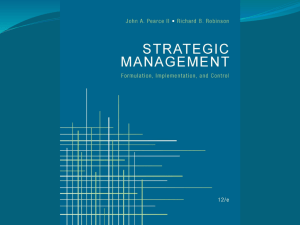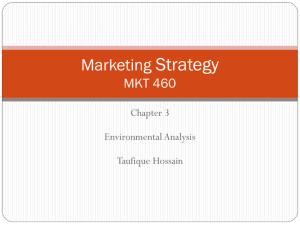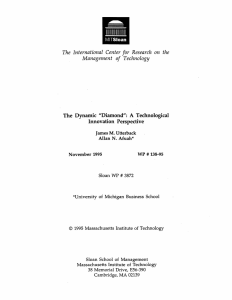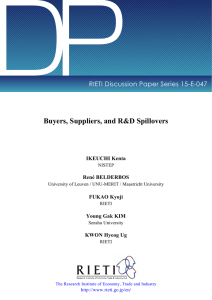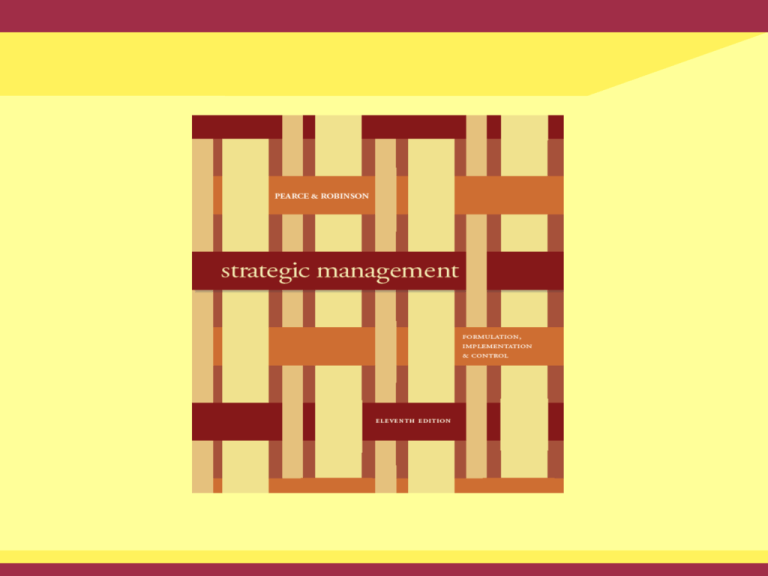
The External Environment
Chapter 4
McGraw-Hill/Irwin
Copyright © 2009 by the McGraw-Hill Companies, Inc. All rights reserved.
Learning Objectives
1.
2.
3.
4.
5.
6.
7.
Three tiers of environmental factors that affect firm
performance
Five factors in the remote environment
Examples of the economic, social, political,
technological, and ecological influences on a business
The five forces model of industry analysis and give
examples
The influences of entry barriers, supplier power, buyer
power, substitute availability, and competitive rivalry on
a business
The five factors in the operating environment
The influences of competitors, creditors, customers,
labor, and direct suppliers on a business
4-3
The Firm’s External Environment
Comprised of following Components:
Remote environment
Industry environment
Operating environment
4-4
Firm’s External Environment
4-5
Societal Environment
Important Variables
Economic
Technological
Political-Legal
Sociocultural
GDP trends
Total government
spending for R&D
Antitrust regulations
Lifestyle changes
Environmental protection
laws
Career expectations
Interest rates
Money supply
Inflation rates
Unemployment levels
Total industry spending
for R&D
Focus of technological
efforts
Wage/price controls
Patent protection
Devaluation/revaluation
New products
Energy availability and
cost
Disposable and
discretionary income
New developments in
technology transfer from
lab to marketplace
Productivity
improvements through
automation
Tax laws
Special incentives
Foreign trade regulations
Attitudes toward foreign
companies
Laws on hiring and
promotion
Stability of government
Consumer activism
Rate of family formation
Growth rate of population
Age distribution of
population
Regional shifts in
population
Life expectancies
Birth rates
6
Remote Environment
Economic Factors
Social Factors
Political Factors
Technological Factors
Ecological Factors
4-7
Economic Factors
1.
2.
3.
4.
5.
Prime interest rates
Inflation rates
Trends in the growth of the
gross national product
Unemployment rates
Globalization of the economy
4-8
Social Factors
Present in the external environment:
Beliefs & Values
Attitudes & Opinions
Lifestyles
Developed from:
Cultural conditioning
Ecological conditioning
Demographic makeup
Religion
Education
Ethnic conditioning.
4-9
Political Factors
Political constraints on firms:
•
•
•
•
•
Fair-trade Decisions
Antitrust Laws
Tax Programs
Minimum Wage Legislation
Pollution and Pricing Policies
4-10
Technological Factors
Technological forecasting helps protect
and improve the profitability of firms in
growing industries.
It alerts strategic managers to
impending challenges and
promising opportunities.
The key to beneficial forecasting of
technological advancement lies in
accurately predicting future technological
capabilities and their probable impacts.
4-11
Ecological Factors
Ecology refers to the relationships among
human beings and other living things and
the air, soil, and water that supports them.
Threats to our life-supporting ecology
caused principally by human activities in
an industrial society are commonly
referred to as pollution
4-12
International Environment
Monitoring the international environment
involves assessing each non-domestic market on the
same factors that are used in a domestic assessment.
While the importance of factors will differ, the same
set of considerations can be used for each country.
Economic, political, legal, and social factors are used
to assess international environments.
One complication to this process is that the interplay
among international markets must be considered.
4-13
Industry Environment
Harvard professor Michael E. Porter
propelled the concept of industry environment
into the foreground of strategic thought and
business planning.
The cornerstone of Porter’s work first appeared
in the Harvard Business Review, in which he
explains the five forces that shape competition
in an industry.
Porter’s well-defined analytic framework helps
strategic managers to link remote factors to
their effects on a firm’s operating environment.
4-14
Competitive Forces Shape Strategy
The essence of strategy formulation is coping
with competition.
Intense competition in an industry is neither
coincidence nor bad luck.
Competition in an industry is rooted in its
underlying economics, and competitive forces
exist that go well beyond the established
combatants in a particular industry.
The corporate strategists’ goal is to find a
position in the industry where his or her
company can best defend itself against these
forces or can influence them in its favor.
4-15
Forces Driving Industry Competition
4-16
Contending Forces Threat of New Entrants
Threat of Entry
Economies of Scale
Product Differentiation
Capital Requirements
Cost Disadvantages Independent of Size
Access to Distribution Channels
Government Policy
4-17
Powerful Suppliers
Supplier is powerful when:
Supplier industry is dominated by a few
companies but sells to many
Its product is unique and/or has high switching
costs
Substitutes are not readily available
Suppliers are able to integrate forward and
compete directly with present customers
Purchasing industry buys only a small portion
of the supplier’s goods.
4-18
Powerful Buyers
Buyer is powerful when:
Buyer purchases large proportion of seller’s
products
Buyer has the potential to integrate backward
Alternative suppliers are plentiful
Changing suppliers costs very little
Purchased product represents a high percentage of a
buyer’s costs
Buyer earns low profits
Purchased product is unimportant to the final
quality or price of a buyer’s products
4-19
Substitute Products
Substitute Products:
Those products that appear to be different
but can satisfy the same need as another
product. To the extent that switching
costs are low, substitutes can have a
strong effect on an industry
4-20
Jockeying for Position
Intense rivalry related to:
Number of competitors
Rate of Industry Growth
Produce or Service Characteristics
Amount of Fixed Costs
Capacity
Height of Exit Barriers
Diversity of Rivals
4-21
Industry Analysis
& Competitive Analysis
An industry is a collection of firms that offer
similar products or services.
Structural attributes are the enduring
characteristics that give an industry its
distinctive character.
Concentration refers to the extent to which
industry sales are dominated by only a few
firms.
Barriers to entry are the obstacles that a firm
must overcome to enter an industry.
4-22
Competitive Analysis
1.
2.
3.
How do other firms define the scope of
their market?
How similar are the benefits the customers
derive from the products and services that
other firms offer? The more similar the
benefits of products or services, the higher
the level of substitutability between them.
How committed are other firms to the
industry?
4-23
Operating Environment
Also called competitive or task environment
Includes competitor positions and customer
profiling based on the following factors:
Geographic
Demographic
Psychographic
Buyer Behavior
Also includes suppliers & creditors and HRM
4-24
HR: Nature of the Labor Market
Access to personnel is affected by 4 factors:
Firm’s reputation as an employer
Local employment rates
Availability of people with the needed
skills
Its relationship with labor unions.
4-25
Emphasis on Environmental Factors
Differing external elements affect different strategies
at different times and with varying strengths
Only certainty is that the effect of the remote and
operating environments will be uncertain until a
strategy is implemented
Many managers, particularly in less powerful firms,
minimize long-term planning
Instead, they allow managers to adapt to new
pressures from the environment
Absence of strong resources and psychological
commitment to a proactive strategy effectively bars a
firm from assuming a leadership role in its
environment
4-26

